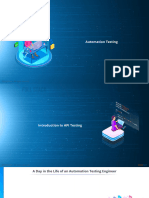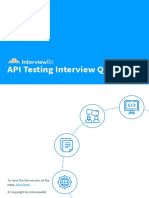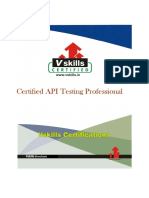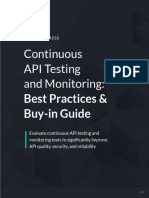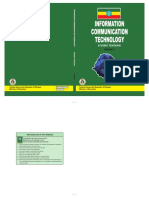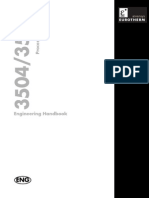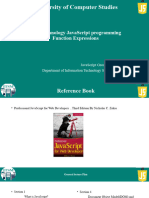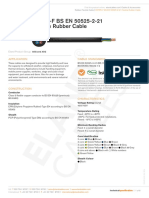✅
API Testing
Introduction
What is API testing?
Why API Testing matter
Benefits of API testing
Types of API testing
Unit testing
Integration Testing
Performance testing
Load testing
Runtime error detection
Security testing
Interoperability testing
Fuzz tests
Validation Testing
Manual Testing vs Automated Testing
How to get started with API testing
Best Practices of API Testing
Introduction
APIs are becoming very important in our modern world and as technology
rises, so will our reliance on APIs. Everything that communicates on the internet
these days is talking to an API (Application Programming Interface) and as we
implement them in our technologies we also need to take API testing into
account. As with everything, our API's need to be tested properly and
thoroughly on many different quality characteristics because if we think about
it. Not only should we pay close attention to the functional requirements but we
should also pay the appropriate amount of attention to non-functional
requirements.
API Testing 1
� What is API testing?
API testing entails various different aspects and goes much further than simply
executing a few test cases. Testing needs to start at the earliest possible stage
and continue on until the production release. To highlight these stages, we will
be following a fictional feature throughout its software development lifecycle.
We need to start our API tests at the source which would be the requirements.
These need to be reviewed very well and from the perspective of a tester.
Testers often try to look for edge cases and they will attempt to find ways to
break a system. This should be taken into account when reviewing the
requirements.
After our requirements have been approved by all stakeholders, test case
development can begin. In this stage the testers will start designing their test
cases which they will combine into test suites. They also have to make sure to
adept their sanity checks to include this new functionality if that is required by
the risk and priority of that new feature.
API Testing 2
� Next we need to determine the test specification which is a document that
describes what the expected results are for all the test cases and what the test
conditions are under which we can both enter and exit our test, in other words
when a test is ready to go and complete. These are also known as our entry
and exit criteria.
Copy of Entry and exit criteria example
Entry criteria Exit criteria
Integration documentation is available Unit tests have been created
Test environment is available Documentation has been created
3rd party integration has been
95% of the test pass
described
There are no more blocking defects
Untitled
outstanding
When all of the documents have been delivered and the software is ready to be
test, the test execution and reporting phase starts. Reports are created based
on the test management tools and they will usually include a full report on the
tests that have been run for a feature, including the results and any blocking
issues encountered which might have halted testing.
Along all of these tests, it is also a good idea to implement a solid test
automation strategy which will cut costs drastically if done right and can be
API Testing 3
� achieved using open source tools such as SoapUI, JMeter, Selenium, postman
or any of the other tools out there.
Why API Testing matter
Now you might be wondering why API is so important and that is
understandable. After all it costs a lot money and is not something you will
always see the direct return of investment in. If you neglect to do this correctly
however, you may find that the costs of the defects racks up much higher than
the cost of the testing ever could.
Since APIs sit at such a central location, they also have most of the traffic to
process and if they fail in unexpected ways, the consequences might be dire. A
failure of any API could lead to services not being available, processes not
working as expected and even allow access to objects and data that should not
be accessible.
API Testing 4
� Another often overlooked aspect of APIs is the fact that it's not just the user
facing functionality that needs to be tested, but often our APIs also integrate
with other services or 3rd party providers. These all rely on our APIs passing
expected and sane data.
Benefits of API testing
When we perform our API testing, one of the biggest benefits we can enjoy is
that we can often test early. This is because the API component is often
developed before the UI component which allows for swifter feedback as well
and it can help steer development on the components that integrate with our
API or even adept our API if need be.
API testing is also a lot cheaper than manual e2e testing or automated UI
testing because we can create much more fine grained component tests that
we do not have to repeat every as often as our end to end scenario's.
All of these benefits allow us to leave enough room for security testing where it
is most impactful, the API level. Security testing on all level is useful of course
but we do not live in a world with endless budgets so we have to put our
priorities in order.
If we have tested our APIs well and documented them properly, we can allow
for a much smoother integration and we can ensure that whatever interface
subscribes to our API, they are well informed and ensured of a tested API.
API Testing 5
� Types of API testing
Unit testing
Unit testing are tests that are written to automatically run with every build of the
application. They are written close to the code and should pass when running a
build of the application. What type of code coverage is required for the APIs
depends on the risk the API carries and what functionalities it holds. Good unit
testing is like a good foundation and this aspect should be well thought over as
it will carry the rest of the testing effort later down the line.
Integration Testing
Our APIs are no separated component of a system. Instead they work to
integrate all of the moving parts of a system and all of this integration requires
proper testing of course. Not only do we need to make sure we are passing on
and taking in the correct parameters with their correct constraints but we also
need to make sure that we sanitise the incoming traffic in a logical way.
API Testing 6
� Performance testing
Performance testing is one of the non-functional that is most often overlooked
and will most often cause trouble. Be very aware that our testing environments
often only contain a fraction of the data that production does so any process
that runs might take a lot more time in a real scenario. Performance testing
should take everything into account including spikes in traffic and multiple
heavy processes running at the same time and interfering with one another.
Also be aware that the environment that is used for testing needs to be similar
to a production environment to get reliable results.
Load testing
Load testing is very similar to performance testing because we are trying to
emulate production like traffic but instead of creating spikes in traffic we want
to emulate a constant steady stream of traffic at a normally expected rate. This
API Testing 7
� is to ensure that the API's do not contain memory leaks or other similar defects
that might cause issues after running for a prolonged period of time.
Runtime error detection
During all of these tests, we want to make sure that we have Runtime error
detection enabled. This technology allows our APIs to report back any defects
that occurs while it's in operation.
Security testing
This type of testing is very important but often not budgeted well. We need to
ensure that proper security testing occurs based on a risk analysis. This type of
testing needs to occur by a trained professional as it's very easy to miss things
but it does not stop there. Every developer should in essence be a little bit of a
security tester when it comes to APIs as they are often the first line of defence
into our infrastructure.
Security testing has many aliases such as pentesting, PEN testing or
penetration testing and needs to focus on several aspects when it comes to api
testing. the entry points of our APIs needs to be taken into account but also the
flow of data and any shadow APIs that are no longer in user but are still in
operation.
Interoperability testing
API Testing 8
� Working with 3rd party software providers or even older versions of our
software is not something we can take for granted. We need to create a section
in our test plan where we describe what testing will be done. Severity and
priority of potentials defects need to be discussed based on prior experiences
and they need to help define how API testing occurs when the APIs interact
with
Fuzz tests
As a final test before we validate our application we need to fuzz all the
endpoints of our APIs. When fuzzing we will send random data to those API
endpoints and we need to carefully inspect the results. Our server should not
crash from this unexpected traffic and it should not display any odd behaviour.
Based on a risk analysis, fuzz testing might be performed much more
structured or not at all.
Validation Testing
During validation testing we need to ensures that the software meets the
business requirements. The testers need to evaluate if the test execution
results match what is expected and required by the test plan. They will
subsequently guide the business users in their User Acceptance Testing (UAT)
in which they ensure the stakeholders execute the pre-built testing scenario's
and report any deviations on what was expected. If the software is approved
API Testing 9
� Manual Testing vs Automated Testing
When thinking about automated testing, we need to take into account that it's
expensive to create these tests and maintain them. After all, when the flow of
the application changes, our API call order or the parameters might not be set
correctly anymore. Every change like this requires changes in our test
automation framework and even setting up the framework might be a big
investment. You will find however that often this investment is more than worth
is if you have to run a suite of tests every day or every release to the test
environment. As a general rule of thumb i try to think that something is worth
automating if you have to test it at least 10 times.
API test automation has many advantages as well. We can write test scenario's
very quickly so we can easily create test cases for a lot of edge cases. We also
don't have to run the tests manually so much and we can include our build
pipelines. If a build produces too many error at that moment, we want to be
informed before we even start testing as a new build will be inevitable after
fixing the errors that were found.
How to get started with API testing
Define the API requirements: Writing good requirements is very hard. open
communication is important to define proper requirements as every
stakeholder can have useful input on the requirements and some very
tough questions needs to be answered to which no single human can have
the answer. This is why team work matters, developers, testers, system
architects, analysts, product owners... they all know their domain best and
should be included in the creation of requiremensts.
API Testing 10
� What will this API be used for?
How will the application handle data?
How will the system handle failure?
How will the system handle output?
How will the system handle unexpected input?
What are the requirements for the fields the API sends out and
receives?
How the API will interact with other APIs, such as which protocol will be
used,...
Entry and exit criteria
The pass and fail criteria for the API/feature
Next we need to set up a good testing environment that is as representative
of a production environment as possible.
Make sure to include a review phase for documentation as well, this is also
known as static api testing because we are reviewing documentation that is
not getting executed
Create a small Proof Of Concept by executing 1 API call before going deep
into the API and setting all your scripts to work.
At this stage we plan our fuzz testing an all other functional testing that has
not been identified yet including which tests will be executed at what level
Optionally develop stubs and drivers so that testing does not have to wait
for integration with a full environment before they can start testing
Integrate your API with the full environment and execute your end-to-end
testing scenario's
Check your test execution results and see if they match the requirements. A
failed test case does not automatically mean that the whole feature should
be disapproved for production. Careful risk assessment should take place
after root cause analysis.
Implement any fixes that are required and retest all the failed features
When all the requirements have been satisfied, start your User Acceptance
Testing (UAT)
API Testing 11
� Optionally, implement any fixes if they are required and retest the failed
functionality
After all the documentation has been delivered and the requirements have
been satisfied we can approve the feature and give it a GO for production
Perform a sanity check on the production release before you release it to
everyone
Follow up on your production releases by checking any logs you have or
any potential service desk instances
Best Practices of API Testing
It is important we group our test cases well by functionality. This will
improve maintainability and will give a better overview of the status of the
application
API Testing 12
� Make sure you include the API's workflow, how it fits in the application and
the edge cases into the requirements and make sure all stakeholders are
involved in the creation of these requirements
We need a testing environment that closely resembles production to test
API requests against. While it's possible to test against stubs and drivers to
start development or speed it up but we need to make sure to always test
end-to-end scenario's on a sandbox environment.
Follow the testing triangle carefully. This means that you automate what is
not possible to be tested via unit or integration tests. Automation is a big
cost saver and can detect serious issues early on if implemented correctly
API Testing 13
�API Testing 14
























